Simple and tough Scorgie sprayers clock 12,000ha in Perthshire
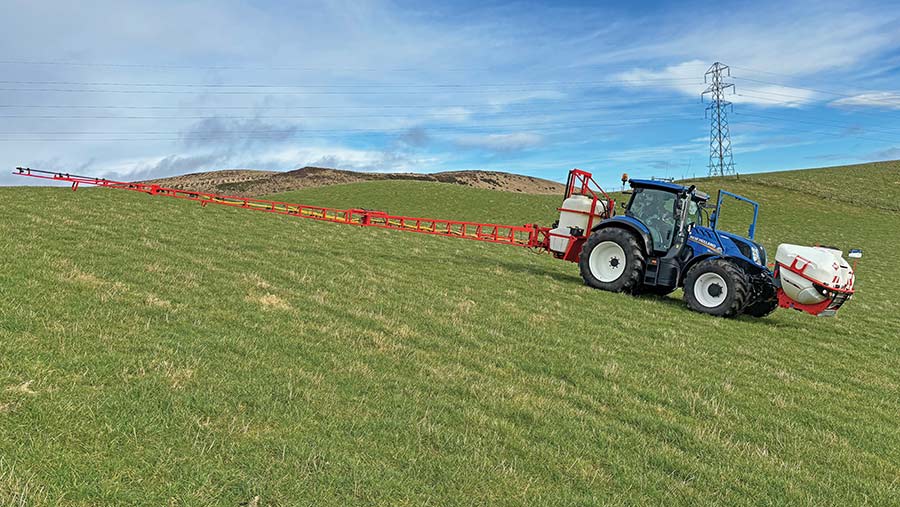 © James Andrews
© James Andrews Steep slopes, unforgiving potato ridges and plenty of rainfall are just a few of the reasons why Mungo and Joy Howat run a fleet of high-capacity mounted sprayers.
Unlike self-propelled machines, their four New Holland tractors offer plenty of traction, good brakes and a low centre of gravity.
Plus, they’re strong enough to handle the unforgiving workload without requiring a heavy maintenance regime.
See also: Driver’s view: Rob Hadley rates his Grim self-propelled sprayer
Continuing the rugged theme, the tractors are teamed with custom-built 28m sprayers from Brechin-based manufacturer Scorgie.
Two of these are fitted with 1,500-litre tanks front and rear, with another benefiting from a larger 1,800-litre vessel at the rear.
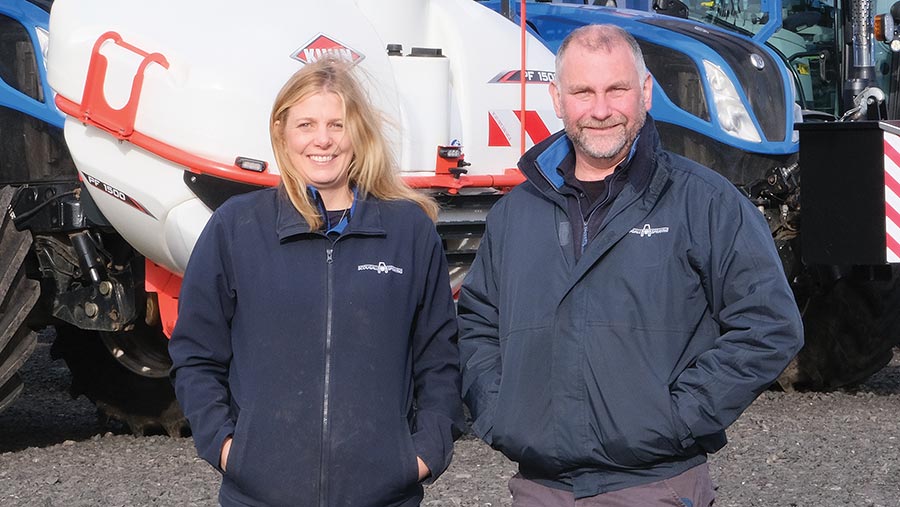
Joy and Mungo Howat © James Andrews
This gives them sufficient capacity to rival typical self-propelled machines used by other contractors in the area, particularly as each tractor has a corresponding 6,000-litre water bowser that can be towed behind.
The fourth setup is a 1,500-litre saddle-tank with just a boom mounted at the rear.
At one time the firm exclusively ran sprayers configured like this – as featured in Farmers Weekly in 2016.
But the need for greater capacity, and the fact the tanks are hard to fit on modern tractors, means they’ve gradually been phased out.
The Howats’ Abernyte-based business, James Scougall Agricultural Spraying Specialists, was set up by Joy’s father Jim in the early 1970s and now covers more than 12,000ha across Perthshire and Angus.
Seed potatoes and malting barley make up the bulk of their spraying area, but they treat a broad spectrum of other cereal crops, plus oilseed rape and pulses. They also apply a sizable amount of liquid fertiliser.
Mungo is a Basis-qualified agronomist, putting together recommendations for much of their spraying area, and they also supply a large chunk of the chemical.
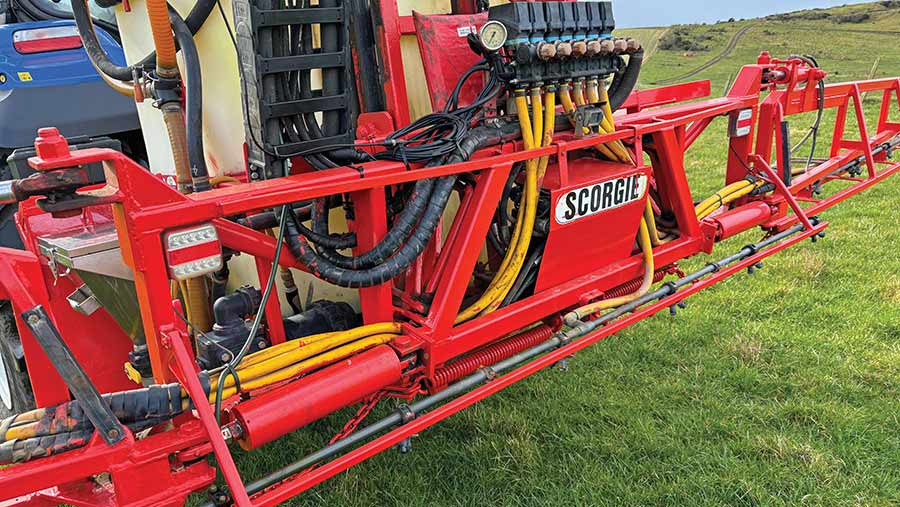
© James Andrews
Adaptable sprayers
Customers vary dramatically in scale and they work with an array of tramline and bed widths, which is another benefit of the Scorgie setup.
“The booms are split into seven sections and they’re configured so that we can spray 12m, 18m, 21m, 24m and 28m tramlines,” says Mungo.
“We can also switch off the two outside nozzles for spraying cereals at 27m, and the fact that the rear section is 3m means we can cover just two rows of beds if we need to.”
Another party trick is the fact that each side of the boom can be folded independently, allowing them to spray awkward areas and quickly nip around obstacles such as trees and electric poles.
“We can even spray with the boom at a slight angle, which comes in handy for some of the beds we work on.”
The steel booms also have variable geometry, allowing each side to be adjusted up or down independently.
This helps them keep a consistent height over undulating terrain and avoids the problem of one end of the boom diving into the crop or hitting the ground while the other is lifted.
There’s no auto-levelling system, so the operators need to make all these adjustments by eye.
To avoid having multiple spool valves at play, booms run off the tractors’ load sensing hydraulic lines and they have an electro-hydraulic spool block controlled by a bank of switches in the cab.
For tractors that don’t have a load-sensing line, the system will operate just as well with a single spool valve set to constant pump.
“Like everything on these sprayers, it’s simple and straightforward, with just the right amount of technology to help us get the job done efficiently,” says Mungo.
The only downside of the boom is that the twin-fold setup means they run up the side of the cab and rest on a frame that mounts off the chassis.
This makes them look clumsy compared to some vertical folding boom setups and they restrict access into the cab when fully folded.
“You only really notice this when you start off in the morning, as once we’re up and running we can fold the boom out slightly to improve access – it’s a small inconvenience, considering how versatile and tough the booms are compared to most mainstream machines,” says Mungo.
Other features include Arag Bravo 400 spray controllers that offer GPS auto-section control and job recording, as well as lightbar guidance for spraying grassland.
The induction hopper and pumps are also sourced from Arag, the tanks come from Landquip, leaving Scorgie to concentrate on the metalwork and piping.
Plumbing is intentionally kept simple, with no recirculation system and just seven Arag solenoid valves controlling the flow of liquid to the boom.
The only downside of the setup is that it can take a while for chemical to get to the outside nozzles and it makes washing out more laborious.
“For this reason, we try to dedicate a sprayer to a specific job in peak season. It means there’s less washing out to worry about and we’re not running the risk of damaging crops,” says Mungo.
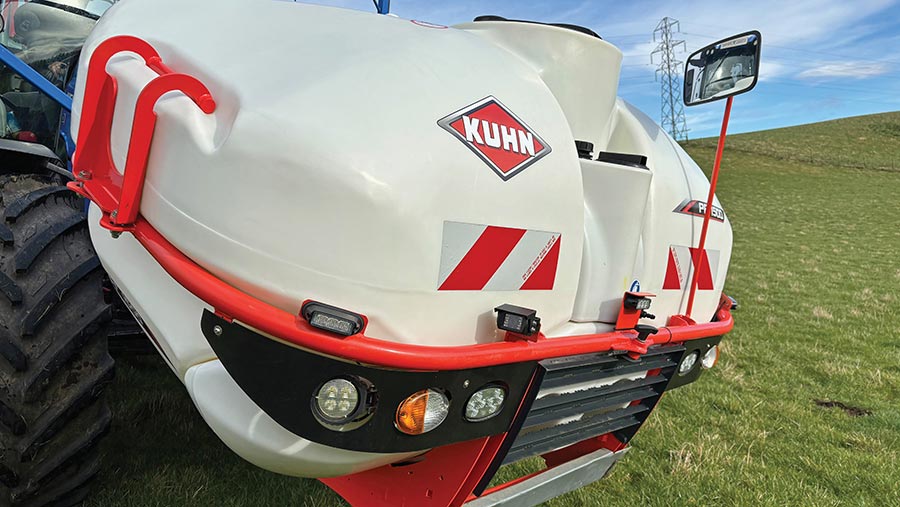
© James Andrews
Front tanks
One of the front tanks is a Scorgie unit complete with 400-litre/min transfer pump and a solenoid valve that allows them to send liquid to the rear tank on demand.
This helps them keep the machines balanced on steep ground as they can move liquid back before the rear tank fully empties.
The second is a home-made version of the above, assembled using a Bargam chassis, tank and frame, to which they fitted their own Hypro transfer pump and electrics.
As for the third, this is a Kuhn PF1500 that Mungo bought second hand because it was cheap, came with lots of extras, and he liked the look of it.
However, it turned out to be a poor investment as the original 125-litre pump was too slow and weak to deal with the volume of liquid they were pumping.
“We went through four pumps in two years, so eventually it was converted to the same 400-litre/min pump as the others.”
This transformed it, but the deep profile of the tank means it’s at greater risk of hitting the top of potato ridges or grounding out when driving through ruts.
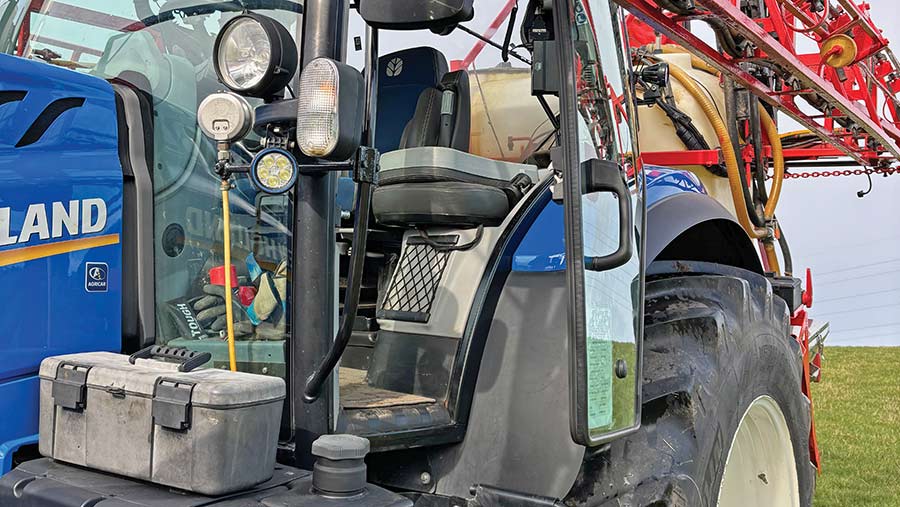
© James Andrews
Tractor setup
Both of the 3,000-litre sprayers are saddled to New Holland T6.180 tractors, which are big enough to handle the sprayers without being too clumsy and heavy.
One is shod with 650mm tyres for autumn work, with the other running 710s.
The latter is the machine they tend to use early in the season when the ground is at its wettest. “It makes very little mess, so we can get on earlier than we could with most self-propelled machines,” says Mungo.
Their biggest 3,300-litre setup is now hooked to a larger-frame New Holland T7.210. According to Mungo, the smaller T6s can handle it OK, but the T7 is that bit more planted.
“It also has the benefit of bringing in some extra income hauling tatties when the spraying work has tailed off,” he says.
For later-season spraying, the T6s are put on a 48in set of row crops and the T7 runs a larger 50in set, giving them enough ground clearance for most jobs.
The pick-up hitches do drag through the crop though, particularly the two Bill Bennet versions that have been fitted on the T6s.
The reason for this is that they can be operated independently to the link arms so that the bowser can be dropped off without lowering the sprayer. There’s no such option for the T7, so this runs with a fixed drawbar instead.
Winter maintenance
At the time of our visit in late February, all the sprayers were coming to the end of their winter pampering regime, having had a comprehensive service and repaint of the boom.
This work, combined with their tough and simple build, means the sprayers have a long lifespan.
Two of the models are almost 10 years old and the newest is four, so Mungo and Joy aren’t having to factor in huge sums to keep replacing them on a regular basis.
This makes a little more cash available for keeping the tractor fleet up to date, which is getting increasingly expensive and hard to justify.

